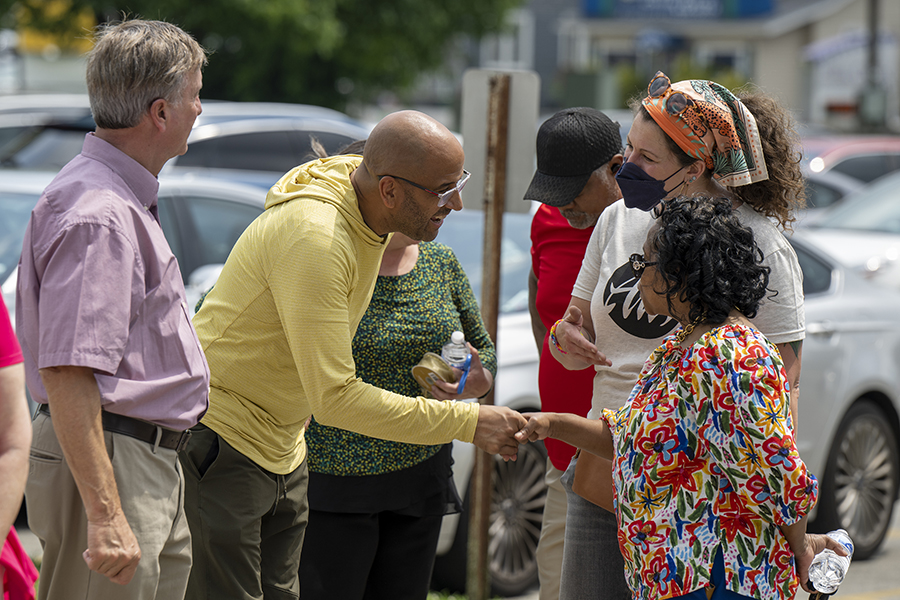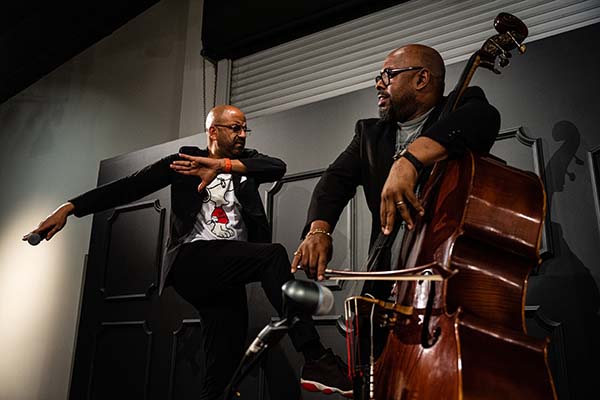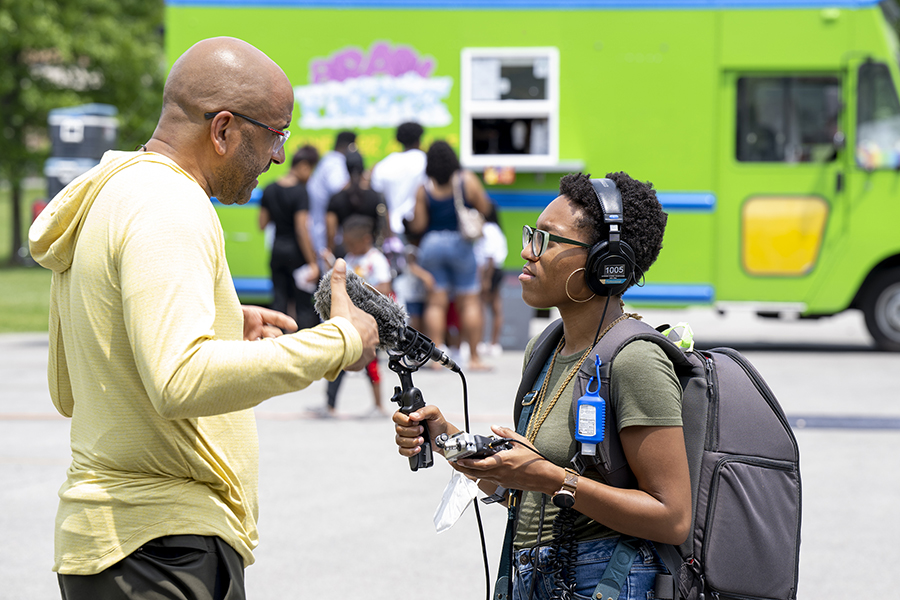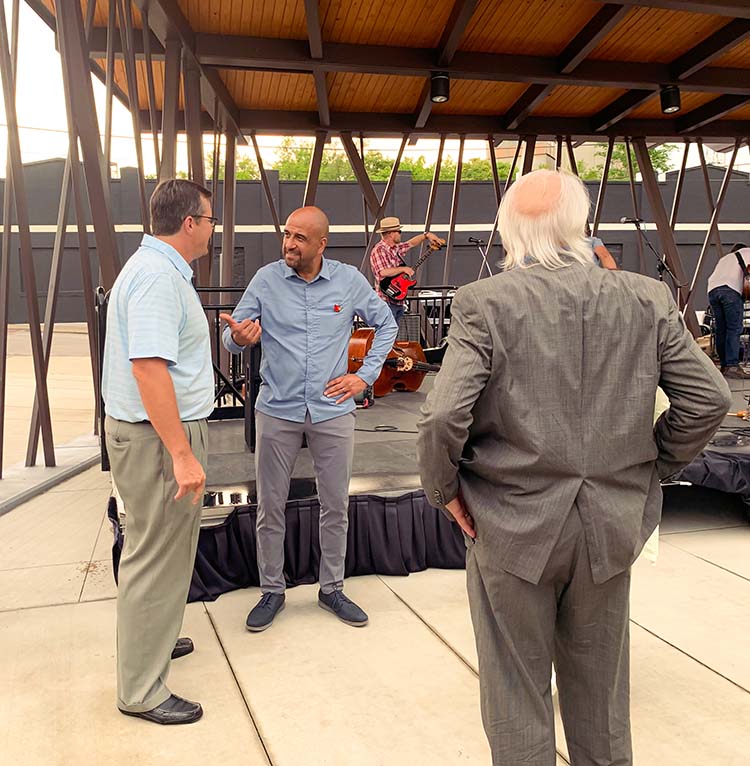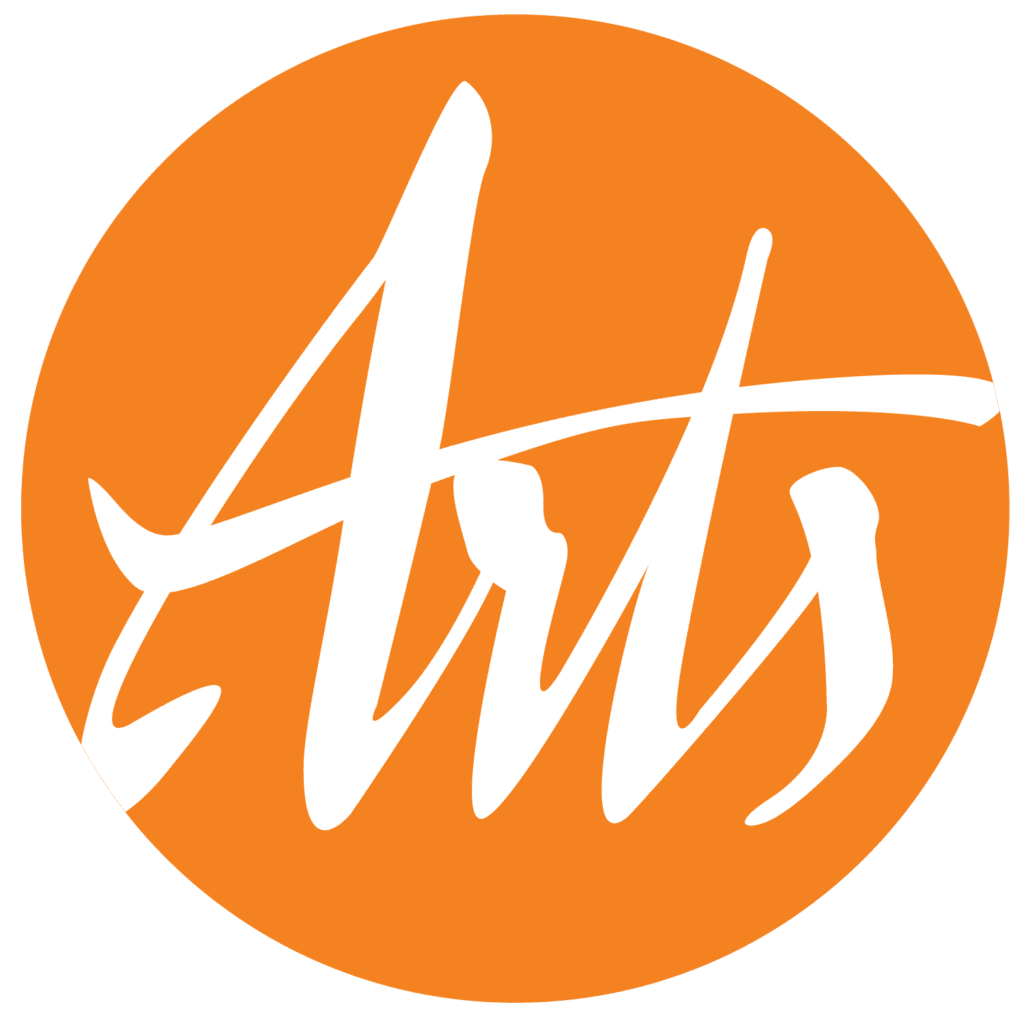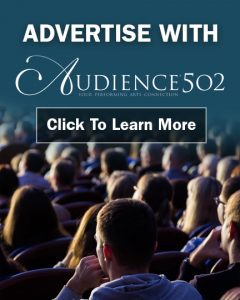The Fund for the Arts is one of the most important organizations dedicated to the local arts. It was founded in 1949 and is one of the two oldest United Arts Funds in the country. The focus of the group is to support, promote, and develop the arts, artists, and arts organizations to help create a healthy and vibrant community for all.
With a vision for a healthy and vibrant community where everyone embraces the art that exists in our lives every day, everyone contributes to the well-being of our arts community, and it is understood that everyone belongs to the arts community, FFTA plays an important role in our arts community.
We caught up with president and CEO, Andre Kimo Stone Guess, who is a Louisville-native growing up in the Smoketown area, and accepted what he considers the right job at the right time just two years ago.
Andre’s energy, compassion and dedication to the local arts scene is inspiring and we are excited to hear what he has been doing in his first two years, what he is working on now, and what he hopes to come in the future.
Listen to the full interview below:
Doug Dreisbach: Thank you for your time today and congrats on your first couple of years at Fund for the Arts. How have things been so far? Has the position been what you thought it was going to be, or have there been some surprises?
Andre Kimo Stone Guess: I didn’t really have any expectations, one way or the other, going in. I was going to sort of look at the challenges and the opportunities as they presented themselves. But having said that, I’ve enjoyed every single day. It’s a blessing and an honor to be able to wake up every day and have the opportunity to move the needle on something that you care so much about, particularly here in my hometown.
DD: When you first came on board, we had a conversation about your interest in the position. Being born and raised in Smoketown here in Louisville, you have a great familiarity with the community, what the community has been through over the last 50 years, 20 years, and especially the last 3 or 4 years. Your passion to make Louisville a great city through the arts and different avenues that Fund for the Arts provides is exciting. How have you implemented that vision? What do you feel that you have accomplished so far? The “I Am An Artist.” campaign, for instance, seems to have been a great idea. Tell us about that program and do you feel it has accomplished the goals as intended?
AKSG: Well, if you think about the way that “the arts” has been viewed traditionally, not just in Louisville—this is through the course of my career in different places, whether it be New York or Pittsburgh—a lot of times we can look at the arts as being someplace you go, someplace you go to experience the arts. So, art is really an external experience from you. And one of the things I reflected upon, and we sort of found out firsthand during the pandemic, is that art is inside of us. And it really is a connection that we make to the arts that we go to, that can make that experience really a vibrant one.
So, in order to make sure that we, number one, created an arts ecosystem—not created, but we were able to have an arts ecosystem where everyone can engage, and everyone can be a part of it—you really have to make the appeal to the person, not about necessarily the art that they’re going to, but it’s like, “What is it about you that makes you susceptible, and makes you want to engage with art along the different continuums and disciplines that we find in art?” So, you can go from the grassroot level of going to an art fair and seeing a local artist. You talk about teaching arts inside the school, all the way up to world-class arts experiences, like the Louisville Orchestra who just put out a new record on Deutsche Grammophon, I think, with Teddy Abrams and Yuja Wang. It just came out last month and it’s this world-class recording of a beautiful concerto that Teddy wrote, and it took place right here in Louisville. What a beautiful tradition of the Louisville Orchestra, with new music, and being the first orchestra in the country to have its own recording company back in the ‘50s. So, we sort of span that entire continuum of art experiences. How do you make it so that the average person can see themselves as a part of that entire thing?
The way that I believe you can do that, and the way that we sort of take it on as an opportunity to do that, is the “I Am An Artist.” campaign, which is the belief that art is a right, not a privilege. It’s not something that’s for some people and not for others. It is a right. It’s a fundamental right. And the main reason we see it as a right, not a privilege, is because art is a fundamental expression of the human condition. It’s how we as human beings really make sense of the world. It’s how we engage. It’s how we story tell. It’s how we celebrate. It’s how we mourn. It’s really a way that we connect with others. And so, if you get down to the most irreducible essence of what it means to be a human being, and the creator spirit thereof, art is part of that.
I love this Latin expression, which is ars longa vita breve, which means art is long and life is short. And a lot of the artists that have stood the test of time, that we celebrate, and whose art—like Shakespeare, or Bach, or Beethoven, or Charlie Parker, or Thelonious Monk, or August Wilson, you name it, these are people who are no longer with us, but their art lives on.
And so, “I Am An Artist.” is a way for us to connect with the thing that makes us unique as a human being, our creative expression, and saying loudly and proudly that that is part of who we are, whether we’re “good at it” or not. And once we’re able to make that connection to who we are as artists, that allows us to connect into those things across that continuum, so that you can bring something about your own expression to the art that you’re engaging with. So, “I Am An Artist.” is really a way to start with the individual, and then start from there and work outward, so that we can create an entire city that will engage with art.
DD: When we met a couple years ago, you talked about the community being on a bus, and basically, regardless of where this bus has been and who has been on it, moving forward, we want everybody on the bus. We want to bring everybody with us for this new vision for the community. So, in addition to “I Am An Artist.,” have you been able to do that and do you see more programs to do that moving forward?
AKSG: We believe that all art is good food and good medicine for our health and well-being and our healing. So, if we were to, individually or collectively as a community, have a nutrition label or those sort of recommended daily allowance, if we look at iron or magnesium or protein or whatever the nutrient might be, you’ll see this thing has 25% of the recommended daily allowance of what you’re supposed to have.
If you were to look at what you needed on a nutritional label and what your recommended daily allowance, what you needed to be a healthy human being, or what your neighborhood or your community needed to be healthy place, you’d see art and culture on there. And the same thing about what it is that you would need to be whole from a human standpoint, if there’s something about you that’s broken and needs mending—you would see art as part of that active ingredient of the medicine that you would need. It may not be the number one ingredient, but it is definitely one of the ingredients that helps to heal us and helps to make us whole.
So, like I said, when we look at engaging the entire community—because if you think about historically, the funding mechanism for the Fund for the Arts as one of the two first united arts funds in the country—the great brainstorm that was started in the ‘80s that created so much—gave us the ability to raise upwards of $250 million over the course of our history, were workplace campaigns. So, we were reaching everyone across the entire spectrum of working in a company or a factory or someplace, so not to look at it hierarchically, but you go from the mail room or whatever to the C suite. And so, if that’s the way that we’ve historically funded the arts, through workplace campaigns, we have to make sure that, as we move forward, that we are engaging with everyone in the community, no matter what neighborhood they live in, no matter how much money they make or what their station in life might be, socioeconomically, because one of the things that we give as an appeal is a dollar a week, $52 a year, to get you engaged with the arts.
So, it’s not only for your ability to contribute, but your ability to engage, so we just want to make people aware of the things that have always been going on. We’re not creating anything new as it relates to arts engagement in our community. We don’t do that. We don’t create art. We’re not an arts organization. We are a funding organization. And so, we’re just trying to make people aware of what has always been there, and connect those engagements in such a way that it creates a vibrant ecosystem throughout the entire city and the community.
DD: When you look at the importance of arts in our community, on a scale of 1 to 10, what is that number and do you think the community also feels that art is equally as important?
AKSG: Whether we realize it, every human being on the planet creates and consumes art every day. You can’t go anywhere without hearing music. We watch television, we watch movies, we tell stories. That’s art. It’s storytelling. It’s acting. It’s scenes. It’s costumes. It’s sound. And so, we are—so, we’re consuming art every day. We walk past murals or paintings and things on the walls of buildings that we go to. We have it on the walls of our home. I’ve got art displayed here. So, we consume art every single day. So, the thing is, on one end, particularly if you think about it from the performing arts or the fine arts perspective, there is this sense that, well, I’m not really doing anything in the arts, because the arts are over here. The arts are in the building somewhere that I have to go to. Yes, that’s true, but it’s everywhere, and we’re consuming it every day, but we go a step further. Everyone creates art every day. So, whether it’s you singing in the shower, you hear a little song and you want to dance to it, you doodle in the corner of a piece of paper, you create bars on some song that you heard that you create on your own, you create some creative lyrics to something—we’re all creating every day. We arrange our furniture to create more of a feng shui thing, whatever it might be, something that’s creative, that’s an expression of who we are. We’re all doing that every day.
And so, what we’re really trying to do is bring an awareness to something that has existed since the beginning of time. We’re not trying to do anything that’s new. We’re just trying to sort of take away this aspect that there’s some line of demarcation or some separation between human beings and art. It’s always there.
So, like I said, we’re not trying to create something that doesn’t exist. We’re just trying to bring some level of awareness to what has always existed.
DD: If you could wave a magic wand and accomplish whatever you want, what would you do?
AKSG: Let me give you an example of what we’re actually doing and let me give you a little bit of the mechanism that we’re going to use to do it, and I’ll tell you what the magic wand would do at the end of that. So, we have what’s called a concentric circle model of engagement. You think about concentric circles. Concentric circles are—one circle starts in the middle. It’s like a bullseye, looks like a dartboard. So, you have these circles, and they’re self-contained. They’re contained inside of one another. But there’s one circle in the middle.
So, if you think about a concentric circle model, the circle in the middle is you. It’s the individual. So, we start with the individual, and we’ve talked about that. “I Am An Artist.” is how we engage with the individual. But if you think, as a human being, after you wake up in the morning, brush your teeth, look at yourself in the mirror, who do you engage with next? You engage with your family, your friends, and your colleagues, right? So, you probably—if you don’t live by yourself, you may live with your spouse or your significant other and/or your kids, or your best friend, your roommate, or whatever. So, those are your family, friends, and colleagues.
We have “I Am An Artist.” for the individual, and the next circle out is our initiative: “Arts in Learning.” We believe in lifelong learning, lifelong engagement. We don’t call our programs education. We call them learning, because if you’re not in school, or if you don’t have a school-age kid, you don’t think it’s for you. So, we believe in intergenerational, lifelong learning, whether it is from taking headphones and putting them on a pregnant belly to let an unborn child hear some music, all the way to sharing a poem with a loved one in hospice as they’re about to take their last breath, and everything in between, so that level of engagement and learning.
And learning isn’t always just a formal thing. It’s an engagement where you’re playing and engaging with a loved one or a family member or a colleague and something. So, we have Arts in Learning, and we have all of our traditional educational things in there, like 5×5, five arts experiences for elementary school-aged kids by their 5th grade year, and then teachers’ art experiences, to be able to get art experiences for kids of all ages in traditional school settings.
As you go from yourself, “I Am An Artist.,” family, friends, and colleagues, to Arts in Learning, go out to the next level. You’ll probably leave the house and engage with someone in your neighborhood on your way to the car. So, we have, not unlike most communities around this country—we have a beautiful tapestry quilt of unique neighborhoods who all have their own artistic identity, artistic flair. And what we want to do is, we want to engage with and invest in neighborhoods around the community, so that they can show off that artistic uniqueness, not only for themselves, but to invite others in.
So, we have an initiative called Arts in Neighborhoods, and that’s our newest initiative. That’s one that started under my leadership, because we want to be able to take individuals and communities and have them—because all arts institutions are actually in neighborhoods. Downtown is a neighborhood—and so to create something that is unique about that neighborhood. It’s not in a competition. And the one thing that we found is that art is the great equalizer. So, it doesn’t matter how well-off the people are in your neighborhood, or how resourced or under-resourced your neighborhood is. Every neighborhood in this community has a great deal of pride in their art, the art that comes from their neighbors. Arts in Neighborhoods is a way for us to engage with them and uplift the artists they want to celebrate in their own communities.”
And so, we go from individual, “I Am An Artist.,” to family, friends, and colleagues, Arts in Learning, to neighborhoods and Arts in Neighborhoods. And really, the next rung out is institutions. And so, in the institution, that’s what the Fund for the Arts has traditionally been known for, is arts in institutions, raising money and giving them to the arts organizations for their sustainability going forward. And that’s usually where the message kind of starts, right? But notice how all of these things allow us to connect with those institutions before we even get to the institution.
“I Am An Artist.” lets you see yourself as, “I can conduct symphonies here. Let’s lead some music.” But I’m not Teddy Abrams, but it connects me with Teddy, right? I can dance with my wife, but I’m not in the Louisville Ballet or Academy of Dance or a grassroots organization here. It makes me susceptible to them when I may come upon them. But one of the ways that I may come upon them is that, through some learning opportunity, my kids, or something that’s going on in the community center, some kind of a learning opportunity, will help me to connect with them. And those arts institutions are engaged in arts and learning. Those arts institutions get invited into neighborhoods. We want to make sure that that connection in the neighborhood, to make it possible—because a lot of times, traditionally, through outreach efforts, arts institutions have gone into neighborhoods, but it may not have been the most successful thing, because everyone in the neighborhood may not have known that that was going on.
But think about it. If the neighborhood actually invites the institution in as a part of a neighborhood initiative that they are doing, and they want you to come in, then it introduces the residents of that neighborhood to that art institution, sort of on their own terms. And think about it—you’re more apt to come to my home if I invite you first. I mean, if I invite you to my home, and you have this big house on the hill that’s sort of downtown, and you invite me first, I may not want to come. But if you come to my neighborhood, and you say, “Hey,” and I invite you in and say, “Come over to my house and hang out and see what we’re doing,” and you bring a little bit about what you’re doing in that big house on the hill, then if you invite me back, I’m more apt to come than if you just invite me to begin with, because everybody comes. So, it’s creating that dialogue between individuals and these institutions, and then we get to the institutions.
So, if we just start at the institutions and work our way back, it’s not as effective as working from one individual and working our way from there. So, we start with the individual, “I Am an Artist.,” family, friends, and colleagues, Arts in Learning, neighborhoods, Arts in Neighborhoods, institutions, Arts in Institutions, and then the last rung is the entire community.
When we get to the entire community, when we get everyone in our community to say out loud, “I Am An Artist,” and to say what their art is, then we will have what’s called a City of Artists. And a city of artists is different than a city of arts, because a city of artists is about individuals. Now, there’s a lot of reasons why someone may not want to stand up, particularly in public, and say out loud that I am an artist, and say what their art is, but it’s not because of the color of their skin. It’s not because of their gender. It is not because of their sexual orientation. It’s not because of where they live or how much money they make, because guess what? Everyone in that demographic continuum, every person, knows someone that fits one of those demographics that is a fantastic artist. So, there’s nothing about who you are that can keep you from being a great artist. Everyone understands that that’s the case. So, you don’t have to build equity into “I Am An Artist.” and a City of Artists. Everyone brings their own unique flair. We just want to create an environment where that is respected and valued, and everyone has that right to express themselves creatively.
So now, one of the things that we’re doing as a part of our 75th anniversary is, we are working on creating an app, and the app will start with Cultural Pass. Cultural Pass is turning 10 years old this year. Cultural Pass was developed in partnership with the city and the Louisville Public Libraries to address learning loss during the summer for kids. Cultural Pass launches alongside Summer Reading through the Libraries to help keep our kids learning and engaged throughout the summer. Cultural Pass gives kids and their grown-ups free access to arts and culture venues and programs while they’re out of school.
An average of about 40,000 passes go out per summer—and for now they’re a completely analogue, physical pass you pick up at the Library. We’re working on an app to turn the Cultural Pass digital. So, in the near future, you’ll be able to get this app, sign up for free for a Cultural Pass, and say, “Hey, what’s going on for eight-year-olds in dance over the next week?” and go do it.
If I could wave a magic wand, every household would sign up for that app when it becomes available, identify what their art is, and tell us what they’re interested in engaging in. So if someone tells us they’re interested in dance, our art partners are able to get information directly to those individuals and households about what’s going on at their organization, how to get involved, how to get tickets, etc. I’d love to wave a magic wand and have every individual in out community sign up for a free Cultural Pass, identify what their art is, and begin to engage, not only with the art, the artists, and the arts organizations, but with each other, to be able to see, “Where’s my intersection of who I am as an artist with all of these other things?” If they do that, we will truly have a City of Artists. That’s the magic wand I would wave, so that everyone is a part of that.”
But we’re building that for that to be possible.
DD: Do you feel like you’re on the right track to get that accomplished?
AKSG: Yeah, our goal is to have the Cultural Pass app built by next summer, and then we’ll layer some other things on top of that. We’re going to layer on a membership. That way you’ll get some extra added benefits for that, like $5 a month as a membership. It’ll be an extension of our workplace campaigns. Remember how I said earlier about a dollar a week, $52? That’s kind of how we went into workplaces. It was the most effective way to reach an individual at that point in time. But now we live in this digital age, the most effective way to reach an individual is through your phone. And so, we’ll have an app where you can come in for $5 a month, $60 a year, and you’ll get well above that in value and discounts and free things to understand what’s going on across the entire arts ecosystem in our city.
DD: What is the best way for somebody to get more information and to get involved?
AKSG: Well, number one is, invest in your own art. Understand what it is about you that’s unique and creative. It doesn’t have to be music, dance, theater, visual, literary arts. What is it about you? What’s your creative expression? What’s the thing that you do? Understand what that is. Embrace it. Say out loud, “I am an artist, and my art is ____,” and then invest your time and resources in your own art, first and foremost. And then, from there, if you want to invest in us, find out what we’re doing, go to FundfortheArts.org. Understand what we’re doing and how we are engaging across that concentric circle model of engagement. We’d love to have you be a part of what we’re doing, but also, with all of the arts organizations that are out there, find a way concentrically—find a way to get engaged in some learning. Find some way to get involved and engaged with the art that’s going on in your neighborhood. Get a ticket to an event that’s going on in one of our beautiful arts organizations, the orchestra, the opera, the ballet, Speed, but not just the crown jewels, because we do have these beautiful crown jewels. Yes, you should absolutely support those. They have world-class art. But find out what’s going on with some of these other grassroots organizations, Little Loomhouse, Portland Art Museum, and I’m just pulling them off the top of my head, some organizations that we represent, not to leave anybody off. Amped is doing some great work.
Get involved with them, either through volunteering or partaking of what they’re doing. But yeah, just find that intersection between who you are as a creative person and what’s going on out there, and get involved. And if you have resources there, we’d love to have you become a member of what we’re doing and donate, as well.
DD: We appreciate your time and effort to make this community a wonderful place for artists and everybody to say, “I Am an Artist.”
AKGS: Thank you for what you guys do, as well, keeping us abreast of what’s going on out there in the arts, and it’s very important.
For more information about Fund for the Arts, visit FundfortheArts.org

